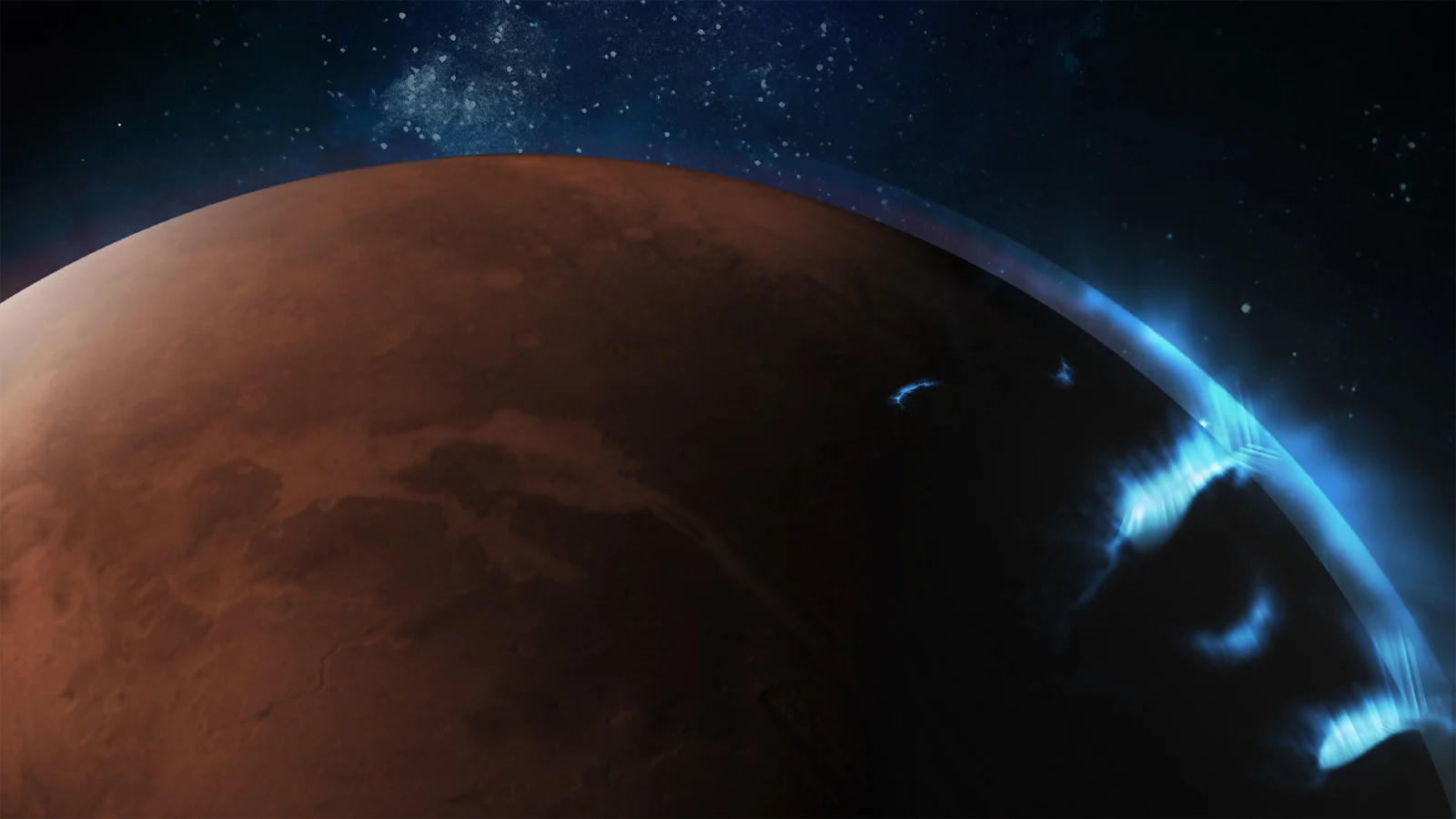
Mars' auroras caught in highest detail ever by Hope spacecraft
The UAE's Mars orbiter spied discrete auroras hovering over the last vestiges of the Red Planet's decaying magnetic field.
Auroras have been spotted on Mars by other spacecraft, but new views from the Emirates Mars Mission are the most detailed to date.
Originating from its molten metal core, Earth projects an immense magnetic 'shield' around itself. This field deflects the worst impacts of space weather and is also responsible for the vibrant auroras that shine in the night sky near the poles.

The lack of a planetary magnetic field around Mars exposes the planet to the solar wind (left), while Earth's geomagnetic field protects our planet (right). Credit: NASA's Scientific Visualization Studio
Mars currently has no global magnetic field. While it appears to have had one a few billion years ago, the cooling of the planet's core caused the magnetic field to decay away. The lack of a planetary magnetic field does not prevent Mars from having auroras, though. The ESA's Mars Express spacecraft spotted evidence of discrete auroras for the first time back in 2004. NASA's MAVEN orbiter recorded a new kind of diffuse aurora in 2016.
Like here on Earth, auroras occur on Mars when solar particles (electrons and protons) are funnelled towards the planet's surface by magnetic fields. When solar electrons collide with atoms and molecules at the top of the atmosphere, they transfer some of their energy along. Those atoms and molecules then dump that excess energy as light. The resulting displays can take the form of diffuse auroras like dayglow, or discrete coloured bands and arcs, such as the Aurora Borealis. Solar protons, on the other hand, pick up an electron during these collisions. They become hydrogen atoms as a result and emit high-energy ultraviolet light in the process.
Martian auroras are unique in one way, though. With no overarching magnetic field to interact with, solar electrons and protons either directly interact with the atmosphere or are captured and concentrated by small, localized magnetic fields projected by magnetized regions of the planet's crust. (Earth has similar localized magnetic fields, by the way, but the field projected by the core is stronger.)

This artist's impression shows discrete auroras over magnetized regions of Mars' crust. Credit: Science@NASA
One of the latest missions to search for auroras on Mars is the United Arab Emirates' Hope spacecraft. After successfully slipping into orbit around the Red Planet in early February, Hope began gathering science data.
On April 22, April 23 and May 6, the Emirates Mars Ultraviolet Spectrometer scanned the planet, collecting observations of the ultraviolet light given off by solar particles striking air molecules near the top of the atmosphere.
The resulting images, released at the end of June, are now the most detailed ever taken of discrete auroras on Mars. As shown in the image below, the planet's dayside shines like a beacon in ultraviolet light to Hope's instruments. However, the spacecraft managed to capture arcs and splotches of auroral light over Mars' night side as well.

These three ultraviolet views of Mars were captured by the Hope spacecraft on April 22, April 23 and May 6, 2021. Annotations point to the discrete aurorae picked up by the instrument. Credit: UAE Emirates Mars Mission
"The beacons of light that stand out against the dark nightside disk are highly structured discrete aurora, which traces out where energetic particles excite the atmosphere after being funnelled down by a patchy network of crustal magnetic fields that originate from minerals on the surface of Mars," the science team wrote on the mission website.

The May 6, 2021 observations by the Emirates Mars Ultraviolet Spectrometer are shown here on the left, with an artist's impression on the right, to highlight the location of the discrete auroras that night. Credit: UAE Emirates Mars Mission
Nick Schneider, a member of the MAVEN team from the University of Colorado Boulder, called the Hope observations "spectacular."
"From my work on the topic, I immediately recognized the way the aurorae draw an outline around the last vestiges of Mars' decaying magnetic field," Schneider told Nature. "These images really capture the fact that Mars has lost its global field, the suspected cause of the disappearance of its earlier thick atmosphere."
VISIBLE OR INVISIBLE?
Here on Earth, auroral displays are most often visible for those at higher latitudes. However, they can extend a significant distance away from the poles when there is a particularly intense bombardment of solar particles from space.

This artist's impression shows what Mars' discrete auroras might look like from orbit if we could actually see them. Credit: UAE Emirates Mars Mission
On Mars, rather than being confined to the polar regions, auroras show up around all the magnetized regions scattered around the planet's surface. So, future Mars explorers won't necessarily need to land near the poles to potentially see Martian auroras. However, we don't yet know whether these auroras will be readily visible to the human eye.
No matter what planet you're on, the brightness of auroras depends on the intensity of solar particle bombardment from space. Equally important, though, is how much atmosphere the planet has. A thinner atmosphere means fewer atoms and molecules for solar particles to collide with, which will result in dimmer auroras overall.

An artist's impression depicts what Mars' auroras could potentially look like from the planet's surface. Credit: UAE Emirates Mars Mission
Unfortunately, the Martian atmosphere is very thin, with less than one per cent of Earth's atmospheric density. So, discrete auroras that occur there may be too dim to see with the unaided eye. But, perhaps following the passage of a particularly intense solar storm, future Mars explorers could gaze up into the night sky to see dim alien auroral displays for the first time.











